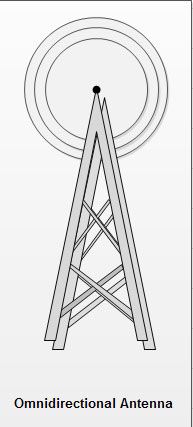Unbound transmission media extend beyond the limiting confines of cabling. They provide an excellent Communication Networks alternative for WANS. The lack of physical restrictions provides larger bandwidth as well as wide area capabilities. Unbound media typically operate at very high frequencies. The three types of unbound transmission media are: Radio wave, Micro wave, Infrared.
Radiowaves Transmission
Although Radio waves are prevalent and well understood, we are just beginning to realize their enormous potential as a networking medium. Radio waves can operate on a single or multiple frequency bands.

Radiowaves are omni directional i.e. they travel in all the directions from the source. Because of this property, transmitter and receiver need not to be aligned. Radiowaves can penetrate buildings easily, so they are widely use for communication both indoors outdoors.
At high frequencies, radiowaves tends to travel in straight line and bounce off the obstacles. They are also absorbed by rain. Radiowaves me widely used for AM and FM radio, television, cordless telephone, cellular phones, paging and wireless LAN.
Microwave Transmission
Microwaves have been used in data communications for a long time. They have a higher frequency than radio waves and therefore can handle larger amounts of data.
Microwave transmission is line of sight transmission. The transmit station must be in visible contact with the receive station. This sets a limit on the distance between stations depending on the local geography. Typically the line of sight due to the Earth’s curvature is only 50 km to the horizon! Repeater stations must be placed so the data signal can hop, skip and jump across the country. microwave circuits considered a broad band communication channel.
Microwaves operate at high operating frequencies of 3 to 10 GHz. This allows them to carry large quantities of data due to their large bandwidth.
List the Advantages of microwaves.
a. They require no right of way acquisition between towers.
b. They can carry high quantities of information due to their high operating frequencies.
c. Low cost land purchase: each tower occupies only a small area.
d. High frequency/short wavelength signals require small antennae.
Disadvantages of Microwaves
a. Attenuation by solid objects: birds, rain, snow and fog.
b. Reflected from flat surfaces like water and metal.
c. Diffracted (split) around solid objects.
d. Refracted by atmosphere, thus causing beam to be projected away from receiver.
Infra Red.
Infrared offers a great unbound photonic solution. Like fiber-optic cabling, infrared communications use light, so they are not bound by the limitations of electricity.
 Dinesh Thakur holds an B.C.A, MCDBA, MCSD certifications. Dinesh authors the hugely popular
Dinesh Thakur holds an B.C.A, MCDBA, MCSD certifications. Dinesh authors the hugely popular